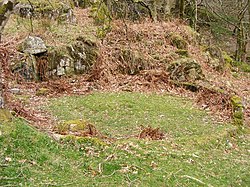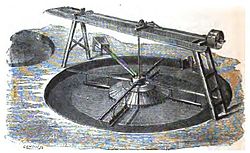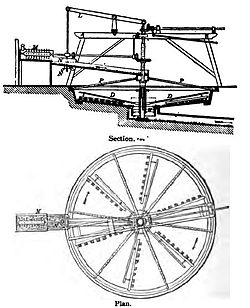119:
small diameter, and then to re-treat the concentrates thus produced in one of a larger diameter. The sides of the buddle pit are formed of stone or brick, set in mortar, and the floor, which has an inclination outwards of 1 in 30, is made either of smooth planed boards or cement run upon a layer of concrete. The centre head is from 6 ft. to 10 ft. in diameter, and may even be less. A revolving head is fixed to the shaft, and this carries four arms. The revolving head receives the slime waters from the trough, and distributes them on an even layer over the fixed head ; the liquid stream, which should be in a uniform thin film, falls over the edge of the fixed head, and distributes itself outwards over the sloping floor of the buddle towards the circumference, depositing in its passage the rich ore it contains, according to its specific gravity, the richest first, close to the fixed head, and the poorest at the circumference. To each of the four arms a board is attached, carrying a cloth or a series of brushes, which sweep round and smooth out each successive layer of mineral as soon as it is formed. In some cases sprays of fresh water are used instead of the cloths or brushes, the number of revolutions in either case being 3 or 4 per minute.
125:
the full thickness of the deposit equal to the height of the cone is reached. At this point the machine is stopped, a groove is cut from the cone to the circumference, and samples of the ore are taken and washed on a vanning shovel. By this means an idea is formed as to where the divisions should be made ; for at the head the concentrates are rich in galena, and then follow the mixed ores, either of galena, blende, and gangue, if blende is present, or of galena and gangue, if it is absent. Two qualities of the mixed ores are formed. Rings are formed around the deposit on the buddle to indicate the division lines. The rich heads are taken out and reworked once in another buddle, when they will be rich enough to be sent to the dolly tub. The middles are likewise re-treated, the ores of approximately the same percentage being treated in the same machine until all the mineral is abstracted, and the waste contains not more than ½ per cent. of lead, and 1 to 1½ per cent. of zinc. By successive re-treatment the minerals may thus be enriched up to 50 to 60 per cent. Pb., and when blende is present, to about 42 per cent. Zn. These concentrates may either be sold as they are, or further enriched in a dolly tub.
28:
20:
48:
36:
124:
The outflow of the waste waters takes place through the small sluice gate shown in the circumference of the huddle. In the door of this sluice is a vertical line of holes, and, as the layer of mineral thickens on the floor, a plug is placed in the lowest hole, and so successively up the series, until
130:
The great drawbacks to the round buddle are the facts that no clean products can be made straight away. The mineral must be handled several times, always a costly proceeding, and the machine must be stopped when full, and lie idle until emptied. A large number of buddles are always required to cope
118:
The buddle itself consists of a shallow circular pit formed in the ground from 14 ft. to 22 ft. diameter, and from 1 ft. to 1½ ft. deep. The poorer the slimes the greater the diameter, and as the product from the buddle always requires re-treatment, it is usual to concentrate first in a machine of
113:
The concentrating machine for slimes, which has hitherto been a great favourite, is the round buddle, and this was perhaps due to the great simplicity of its construction, which permitted its being made out of the odds and ends of machinery usually to be found on a mine. The fixed and revolving
94:
which rotated in the water in order to agitate the mixture. The result of which was that the heavier and denser material - i.e. the ore - tended to collect at the centre of the pit, from where it could be retrieved. The
102:
Usually a set of buddle pits were used to further refine the ore, where the processed ore was put in another buddle until the achieved concentration of the desired mineral was met.
23:
A large buddle pit at
Mulreesh, one of the historic lead mining areas of Islay. A buddle pit was used to concentrate the heavier plumbiferous ores from the lighter rocks by washing.
242:
27:
176:
712:
235:
131:
with the slimes from even a small mill, while in large mills, especially when blende is present, from sixteen to twenty would be needed.
263:
90:
The pit, often constructed from stone, cement, or brick and mortar, contained water and used a set of brushes often powered by a
212:
Mining and mining machinery: explaining the methods of obtaining minerals, precious stones, &c., in all parts of the world
342:
337:
228:
19:
616:
785:
626:
157:
114:
cast-iron heads, shafting, bevel wheels, and driving pulleys, are usually procured from a firm of machinery makers.
871:
866:
87:
and are often circularly shaped. There was also a variation called the concave buddle, which had a concave bottom.
188:
Machinery for
Metalliferous Mines: A practical treatise for mining engineers, metallurgists and managers of mines
107:
Machinery for
Metalliferous Mines: A practical treatise for mining engineers, metallurgists and managers of mines
511:
679:
647:
598:
251:
152:
67:
is an ore processing technique that separates heavier minerals from lighter minerals when the crushed
464:
732:
621:
507:
454:
260:
142:
562:
502:
459:
271:
759:
497:
290:
71:
is washed in water. This technique was used in the mining industry to extract metals such as
31:
Remain of Buddle pit in Cwm Bychan. Another buddle pit nearby still retains the central cone.
840:
745:
717:
305:
295:
830:
790:
666:
482:
474:
411:
399:
394:
389:
780:
611:
577:
541:
449:
332:
320:
860:
835:
740:
722:
707:
702:
697:
692:
572:
567:
84:
772:
492:
487:
444:
147:
642:
606:
434:
366:
91:
845:
795:
588:
517:
374:
315:
687:
652:
522:
406:
349:
47:
35:
815:
582:
554:
379:
220:
439:
416:
384:
310:
16:
A pit for separating heavier minerals from lighter minerals using water
820:
327:
96:
354:
46:
34:
26:
18:
825:
80:
76:
224:
300:
72:
68:
109:, by E. Henry Davies, C. Lockwood and son, 1902 :
808:
771:
758:
731:
678:
665:
635:
597:
553:
540:
473:
427:
365:
283:
270:
190:, by E. Henry Davies, C. Lockwood and son, 1902
111:
236:
8:
51:A diagram of a working concave buddle, from
768:
675:
550:
280:
243:
229:
221:
200:Undiscovered Wales: Fifteen Circular Walks
105:The following detailed extract comes from
39:A diagram of a working round buddle, from
202:, by Kevin Walker, Francis Lincoln, 2010
83:. Many buddles seen today date from the
177:Sine Project - Term Definitions: BUDDLE
169:
158:Adelong Falls Gold Workings (Australia)
99:was then drained off and disposed of.
7:
14:
264:Non-ferrous extractive metallurgy
53:Machinery for Metalliferous Mines
41:Machinery for Metalliferous Mines
214:, by Sydney Ferris Walker, 1913
1:
617:Bottom-blown oxygen converter
888:
55:, by E. Henry Davies, 1902
43:, by E. Henry Davies, 1902
258:
343:Underground in soft rock
338:Underground in hard rock
143:Buddle pits in Dartmoor
134:
56:
44:
32:
24:
671:(by aqueous solution)
503:Gravity Concentration
252:Extractive metallurgy
153:Metal mining in Wales
50:
38:
30:
22:
786:Hall–Héroult process
465:Mechanical screening
508:Magnetic separation
455:Cyclonic separation
276:(by physical means)
261:Metallurgical assay
589:Refractory linings
460:Gyratory equipment
272:Mineral processing
57:
45:
33:
25:
872:History of mining
867:Mining techniques
854:
853:
804:
803:
765:
760:Electrometallurgy
754:
753:
713:Gold chlorination
672:
661:
660:
547:
536:
535:
498:Jig concentrators
296:Natural resources
291:Geological survey
277:
879:
769:
764:(by electricity)
763:
746:Pan amalgamation
718:Gold cyanidation
708:In situ leaching
676:
670:
551:
545:
306:Economic geology
281:
275:
245:
238:
231:
222:
215:
209:
203:
197:
191:
185:
179:
174:
887:
886:
882:
881:
880:
878:
877:
876:
857:
856:
855:
850:
800:
791:Castner process
762:
750:
727:
669:
667:Hydrometallurgy
657:
631:
627:IsaKidd process
593:
544:
532:
483:Froth flotation
469:
423:
361:
274:
266:
254:
249:
219:
218:
210:
206:
198:
194:
186:
182:
175:
171:
166:
139:
17:
12:
11:
5:
885:
883:
875:
874:
869:
859:
858:
852:
851:
849:
848:
843:
838:
833:
828:
823:
818:
812:
810:
806:
805:
802:
801:
799:
798:
793:
788:
783:
781:Electrowinning
777:
775:
766:
756:
755:
752:
751:
749:
748:
743:
737:
735:
729:
728:
726:
725:
720:
715:
710:
705:
700:
695:
690:
684:
682:
673:
663:
662:
659:
658:
656:
655:
650:
645:
639:
637:
633:
632:
630:
629:
624:
619:
614:
612:Parkes process
609:
603:
601:
595:
594:
592:
591:
586:
580:
578:Flash smelting
575:
570:
565:
559:
557:
548:
542:Pyrometallurgy
538:
537:
534:
533:
531:
530:
525:
520:
515:
505:
500:
495:
490:
485:
479:
477:
471:
470:
468:
467:
462:
457:
452:
447:
442:
437:
431:
429:
425:
424:
422:
421:
420:
419:
414:
404:
403:
402:
397:
392:
382:
377:
371:
369:
363:
362:
360:
359:
358:
357:
347:
346:
345:
340:
335:
325:
324:
323:
321:Precious metal
318:
313:
308:
298:
293:
287:
285:
278:
268:
267:
259:
256:
255:
250:
248:
247:
240:
233:
225:
217:
216:
204:
192:
180:
168:
167:
165:
162:
161:
160:
155:
150:
145:
138:
135:
15:
13:
10:
9:
6:
4:
3:
2:
884:
873:
870:
868:
865:
864:
862:
847:
844:
842:
839:
837:
834:
832:
829:
827:
824:
822:
819:
817:
814:
813:
811:
807:
797:
794:
792:
789:
787:
784:
782:
779:
778:
776:
774:
770:
767:
761:
757:
747:
744:
742:
741:Patio process
739:
738:
736:
734:
730:
724:
723:Bayer process
721:
719:
716:
714:
711:
709:
706:
704:
703:Tank leaching
701:
699:
698:Dump leaching
696:
694:
693:Heap leaching
691:
689:
686:
685:
683:
681:
677:
674:
668:
664:
654:
651:
649:
646:
644:
641:
640:
638:
634:
628:
625:
623:
620:
618:
615:
613:
610:
608:
605:
604:
602:
600:
596:
590:
587:
584:
581:
579:
576:
574:
573:Zinc smelting
571:
569:
568:Lead smelting
566:
564:
563:Iron smelting
561:
560:
558:
556:
552:
549:
543:
539:
529:
526:
524:
521:
519:
516:
513:
509:
506:
504:
501:
499:
496:
494:
491:
489:
486:
484:
481:
480:
478:
476:
475:Concentration
472:
466:
463:
461:
458:
456:
453:
451:
448:
446:
443:
441:
438:
436:
433:
432:
430:
426:
418:
415:
413:
410:
409:
408:
405:
401:
398:
396:
393:
391:
388:
387:
386:
383:
381:
378:
376:
373:
372:
370:
368:
364:
356:
353:
352:
351:
348:
344:
341:
339:
336:
334:
331:
330:
329:
326:
322:
319:
317:
314:
312:
309:
307:
304:
303:
302:
299:
297:
294:
292:
289:
288:
286:
282:
279:
273:
269:
265:
262:
257:
253:
246:
241:
239:
234:
232:
227:
226:
223:
213:
208:
205:
201:
196:
193:
189:
184:
181:
178:
173:
170:
163:
159:
156:
154:
151:
149:
146:
144:
141:
140:
136:
133:
132:
127:
126:
121:
120:
115:
110:
108:
103:
100:
98:
93:
88:
86:
85:Victorian era
82:
78:
74:
70:
66:
62:
54:
49:
42:
37:
29:
21:
773:Electrolysis
733:Amalgamation
527:
488:Jameson cell
445:Hydrocyclone
211:
207:
199:
195:
187:
183:
172:
148:Metal mining
129:
128:
123:
122:
117:
116:
112:
106:
104:
101:
89:
64:
60:
58:
52:
40:
809:Co-products
643:Calcination
607:Cupellation
523:Dry washing
512:Magnetation
435:Ore sorting
400:Pebble mill
367:Comminution
92:water wheel
65:buddle pond
861:Categories
846:Stamp sand
796:Downs cell
528:Buddle pit
518:Rocker box
375:Stamp mill
316:Base metal
284:Extraction
164:References
61:buddle pit
688:Lixiviant
653:Liquation
546:(by heat)
407:Ball mill
350:Recycling
97:byproduct
816:Tailings
680:Leaching
648:Roasting
599:Refining
583:ISASMELT
555:Smelting
412:Rod mill
395:SAG mill
380:Arrastra
137:See also
841:Red mud
831:Clinker
585:furnace
493:Panning
450:Trommel
440:Vanning
417:IsaMill
390:AG mill
385:Crusher
333:Surface
311:Mineral
821:Gangue
622:Poling
428:Sizing
328:Mining
636:Other
355:Scrap
836:Chat
826:Slag
81:zinc
79:and
77:lead
301:Ore
73:tin
69:ore
63:or
863::
75:,
59:A
514:)
510:(
244:e
237:t
230:v
Text is available under the Creative Commons Attribution-ShareAlike License. Additional terms may apply.



